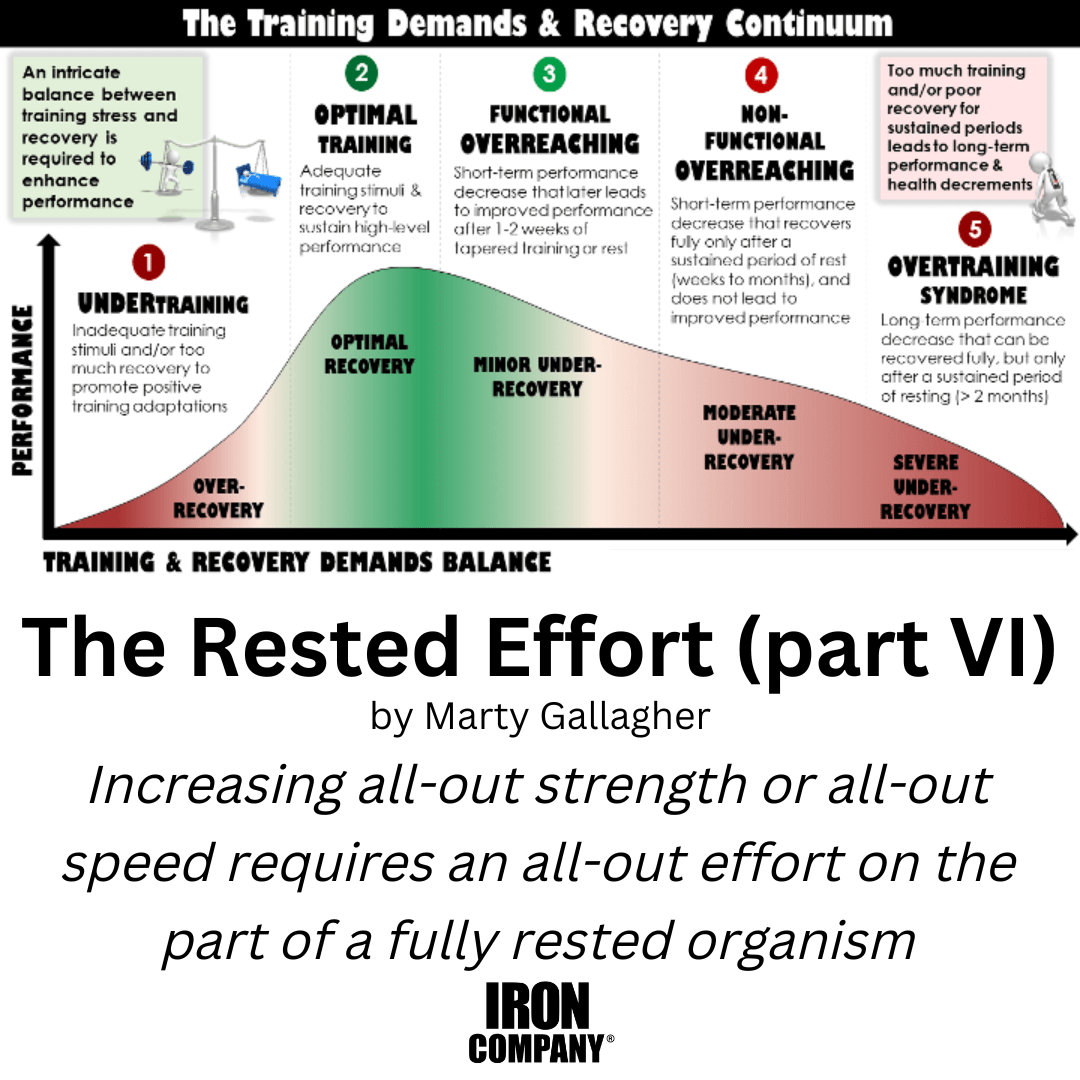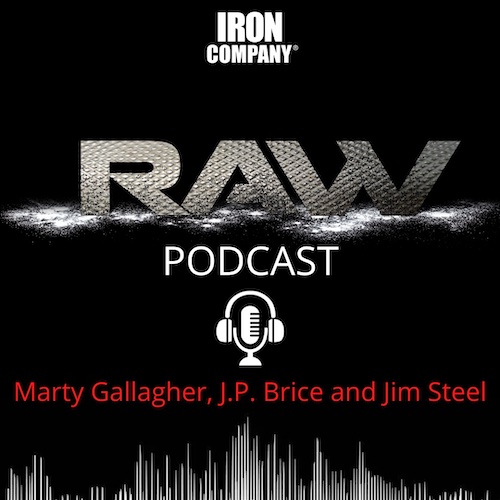
The Rested Effort In Strength Training (part VI)
Increasing all-out strength or all-out speed requires an all-out effort on the part of a fully rested organism
Any in-depth discussion of strength training eventually veers into related discussions on “over-training,” i.e., training so hard, so long, and so often, that the body breaks down and is unable to regain hemostasis in time for the next training session. Too much of a good thing (training) becomes a bad thing.
When over-tonus, over-training, takes hold, it creates deep fatigue and a tiredness that cannot be overcome. In the aftermath of an intense, hypertrophy-inducing training session, overtrained athletes complain that all movement feels like “walking through mud.” Fatigued, lethargic, the over-trained become slow-witted, and mentally dull.
Bodybuilders can experience a different flavor of over-training. The bodybuilding template uses much higher training volume, more sessions, more sets, higher repetitions, forced-reps, drop sets, etc., and if taken too far, this type of resistance training induces a debilitating, “sore-to-the-touch” syndrome where touching or grabbing an over-trained muscle causes a jolt of pain. This is likely caused by waste products trapped by excess edema fluid.
Concern about overtraining naturally leads into discussions on rest, recovery, nutrition, and the various aides, modes, and tools used in 2022 to stimulate and accelerate recovery. Old School strength athletes had a clichéd saying, “There is no such thing as over-training – only under-eating.” There is much truth in this (as there is in most cliches, that is why they become clichés) ancient saying.
If you are training hard enough to trigger hypertrophy and then starve the organism (in relation to the severity of the effort) the organism breaks down. In the wake of a successful training session, an infusion of calories provides nutritional building blocks (glycogen, amino acids, dietary fat) required to heal, recover, and grow. The “cleaner” the calories used to fuel recovery and growth, the less likely the recovery nutrients will end up as body fat: 500 calories of roast chicken, salmon or a recovery shake are superior to 500-calories of ice cream, donuts, or Doritos.
Another novel approach: why not strength train less? Train only when completely healed and rested from the previous session.
In 2022 the conventional thinking is to strength train often, but “spread the effort” by using “split” routines that rotate targeted body parts or lifts: train legs on Monday, chest on Tuesday, back on Wednesday, shoulders on Thursday, arms on Friday, hamstrings, calves, abs on Saturday, take off Sunday and repeat.
I mentored under a world champion superheavyweight powerlifter that trained twice a week and set world records, won the world championship, and created a fleet of national and world champions, myself included. It was a badge of honor to have survived Hugh “Huge” Cassidy’s twice-weekly powerlifting slaughter-fest training sessions.
When modern strength coaches are presented with the proposition that optimal gains can be obtained training twice weekly, they think this sounds preposterous – at best, training twice weekly might be expected to maintain that which had already been attained. Improve? No way!
You had to experience the intensity of this style training to understand it; you had to feel it to grok it. If you trained as hard as Cassidy prescribed, there was no way you could train more than twice weekly – unless you slashed the poundage 50%. We would perform all three powerlifts, plus two “backoff” sets done with higher reps and lighter poundage. The backoff sets were the “hallmark” of his approach.
After barbell squats, benches and deadlifts, we did seating pressing and finished with super-sets of biceps and triceps. In the aftermath, walking up the basement stairs was difficult. When the session was done, we headed to the nearby all-you-can-eat buffet to stuff our faces before taking extended power naps. To survive the Cassidy approach, between sessions, you had to eat like a plague of locusts and sleep like a hibernating Kodiak bear. We needed to regain hemostasis before the 2nd weekly slaughter-fest session 3-4 days later. Calories and sleep were critical.
It was all we could do to recover from one session to the next. Everything was periodized, preplanned every workout over a 12-week, three-month macrocycle was penciled-in at the start of the cycle. A realistic end-goal was arrived at before we commenced. The cycle was reverse engineered back to a starting point. We began every cycle using high-reps and light weights to groove in technique and spark some hypertrophy. The periodized elephant was eaten one bite at a time. In the 1980s, elite strength athletes had to cut the Cassidy template in half: they were not recovering. The classical power template became train each major lift (squat, bench press, deadlift, overhead press) once weekly.
The question I would pose of all these split routines – is the body ever trained when truly rested?
If I knock the dog-piss out of my legs on Monday, sure my pecs, shoulders and triceps are “fresh” for the Tuesday bench workout, after all, pecs, shoulders, and triceps are not involved in the squatting and leg assistance work done Monday – but is that body, blasted squatting the day before, truly, fully fresh and rested for benching on Tuesday? I think not.
If the goal is to improve human strength (or speed) in a measurable, quantifiable way, a 101% effort needs to be generated when the athlete is 100% rested, i.e., completely recovered. Rested results are always superior. How could it be otherwise: no matter how well you performed when 79% rested, performance would have improved if you had been 100% fully rested. My thought is, perhaps the surest way to improve recovery is to eat more clean calories, sleep deeper, and train less. There is an eloquent simplicity to this primal solution to an eternal problem.
About the Author - Marty Gallagher
As an athlete Marty Gallagher is a national and world champion in Olympic lifting and powerlifting. He was a world champion team coach in 1991 and coached Black's Gym to five national team titles. He's also coached some of the strongest men on the planet including Kirk Karwoski when he completed his world record 1,003 lb. squat. Today he teaches the US Secret Service and Tier 1 Spec Ops on how to maximize their strength in minimal time. As a writer since 1978 he’s written for Powerlifting USA, Milo, Flex Magazine, Muscle & Fitness, Prime Fitness, Washington Post, Dragon Door and now IRON COMPANY. He’s also the author of multiple books including Purposeful Primitive, Strong Medicine, Ed Coan’s book “Coan, The Man, the Myth, the Method" and numerous others. Read the Marty Gallagher Biography for a more in depth look at his credentials as an athlete, coach and writer.



